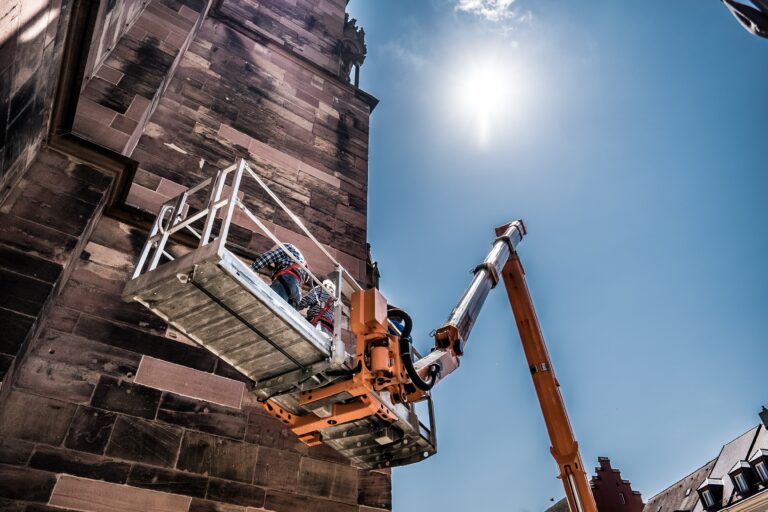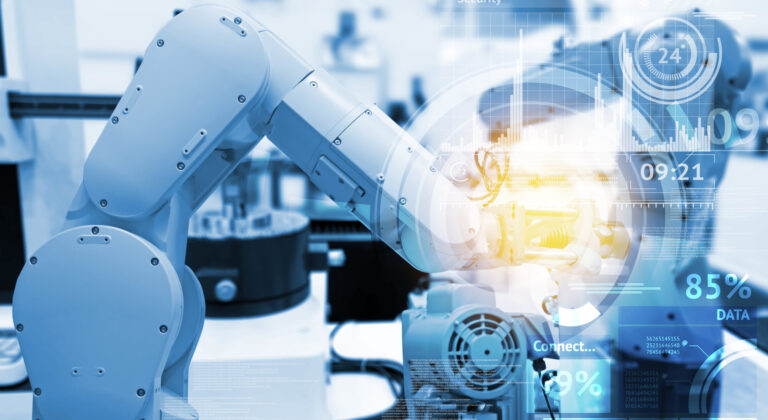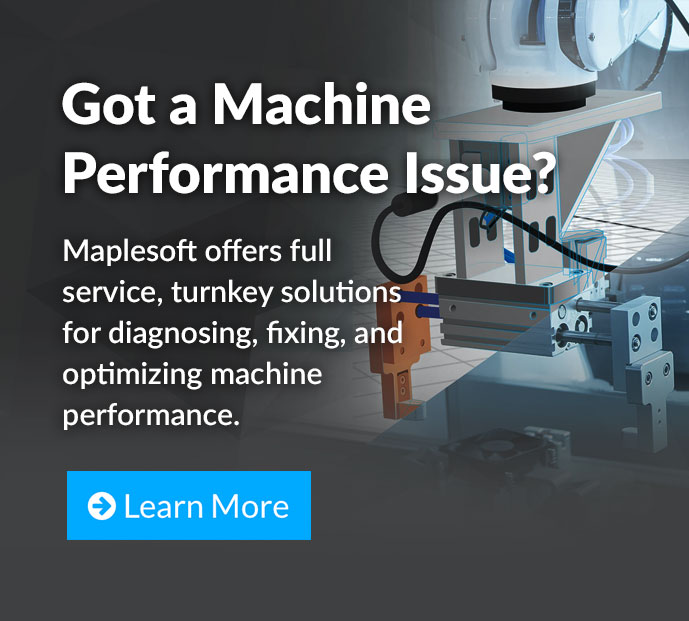
I had the opportunity to sit down with our resident experts in the automation industry: Chris Harduwar, VP of Strategic Solutions at Maplesoft, and Chad Schmitke, Director of MapleSim Development. We had a great discussion about what’s important in automation right now and what automation trends we should expect into this year.
What are you expecting to be big this year in the automation industry?
Chris: I think more companies will embrace the digital transformation. Companies are moving away from solely relying on gut to build new technologies and are moving towards other solutions like digital twins and virtual commissioning. These types of solutions are geared to push the OEM machine builder towards more innovative solutions and faster product development. They’re pushed to be more competitive and there’s an attraction to do things differently.
Most automation companies are only starting to use digital techniques to speed up their workflow. Previously, they’ve been relatively successful in uncovering integration issues as the prototype comes together and fixing it right on the spot. To be competitive, certain forward thinking OEMs are looking for new tools and techniques to shorten the time to market. As people retire in these companies, certain ways of doings things are going out the door. New graduates, a younger generation of engineers and programmers, are coming into the industry with a new skill set. And today, a lot of the skills are computer based. The skills are digital and advanced and include virtual prototyping and simulation based techniques for the design process.
The other push towards having digital tools in the workflow is because machines are becoming more intelligent. They’re becoming quicker, and faster. There are two reasons for this. Firstly, technology is changing every day and machine builders have access to new technologies to drive innovation through machine learning and the smart factory. And secondly, machines are built to produce products. Those products go to consumers who, more and more, want personalized, customized goods. And consumers are willing to pay!
It’s important for manufacturers to be able to switch out production quickly, in order to meet the demand of customers. Smaller batch sizes calls for adaptive machines, smarter machines with new designs, and higher efficiency throughput. In order to do that you need a new school way to do designs that better match consumer needs. This is the where there’s a big push for new tools, like MapleSim, or other digital tools like 3D plant layouts, so you can see designs on a computer before they’re built.
Chad: Yes, that’s true; people want to verify and test things first before they actually build a prototype. But for many companies, they are reviewing ways to boost performance when they already have the machine out there and running. Customers are saying, “the competitors can do this faster, how can I cut my cycle times down?”. So we’re also starting to get people asking if we can build models to do some tuning just for the controllers, to make their machines run faster. If it runs faster, there may be a vibration or there are operator safety concerns. But without shutting down the line to update the machine, how does a company get around this?
This idea of building a model of the machine and performing tests of the machine offline is appealing. This way you’re able to answer the question of “can I make it run faster?”. You’re working from an office to perform these kinds of tests and causing minimal disruption to the customer. That’s not starting from scratch and doing the whole virtual commissioning process, but there’s a push to adapt the tools and technology to what already exists. For many companies it means there’s little disruption to the production line while still improving their machines.
Chris: I think the larger industrial automation companies that provide the hardware are working quickly to bring digital solutions to life because they know that just selling hardware is not enough. A full solution involves a combination of hardware and software, bringing to life the vision of what the OEM wants. All these companies are applying different digital tools and some of them are seeking partnerships with other software suppliers. For example, companies that do 3D-modelling, material analysis, or product flow, together, are building a nice visual experience. In addition, companies that are doing VR (virtual reality) are being sought out by automation companies and are being added to the portfolio of solutions available.
Chad: The thing to keep in mind is that they’re all competing on hardware, but sometimes the margins aren’t that big and so it’s value they’re trying to sell. And that’s where the software solutions are really important.
What are your suggestions and recommendations for companies looking to implement Virtual Commissioning technologies in the next year?
Chad: There are all kinds of technologies related to virtual commissioning, and all kinds of problems you can solve. Things like quality, diagnostics and training, so people can get up to speed faster, are all incredibly important concerns. You really need to examine what the biggest pain points are for your company and start figuring out what technologies will be helpful. If the commissioning phase is the biggest problem area for your engineers, you can start using a digital twin to take care of the sequencing, test your control code, and you can shorten that process. If your competitors have products that are out-performing yours, try to take on a technology that can help you build a more innovative product.
Chris: You really need to explore different technologies and really understand what’s right for your business and for your company. Model-based simulation isn’t necessarily the right fit for everyone. There are so many players out their saying they offer digital twin solutions, but this can mean a lot of different things. It’s important for a company to consider what the individual supplier requires. To do that you really need to go beyond the spec sheet and the marketing material. I would suggest that companies talk to the individuals that are creating the product and truly understand where they bring value.
It’s also important to have trust with the companies you’re working with. You’ll want these companies to be there along with you when things don’t fit properly with software and hardware. If it’s customized, consider what the software provider is giving you to ensure that it fits with your current ecosystem. A lot of times companies have off-the-shelf products that might not fit directly and may look pretty, but when you go to deploy it, it might not be the right thing.
Chad: You’re going to be tackling some challenging problems so again, really make sure you trust the company you’re working with. You might also want to try out a pilot project. Pick a small problem you’re trying to solve and do a test. If you don’t think you can jump to the whole thing right away, start with something manageable. You still have to run the rest of your company when you’re converting this over, so find out what skills you need and find out what’s bringing you value.
How do you see the role of virtual commissioning in automation changing in the next year, and beyond?
Chris: Looking globally, some North American companies feel pressure from global competition, mainly coming from Europe and Japan. These overseas companies have already adopted digital technologies and so the machines are more sophisticated, faster and more efficient. The North American companies, who are just looking at new technologies, are feeling pressure when bidding to win customer’s business.
Chad: From the shows and automation events we’ve been at, we’ve really noticed that the messaging behind virtual commissioning is changing. When the customers talk to us, they understand more and they ask questions that really shows they see the value. I think we’re going to see smaller companies taking steps to adopt virtual commissioning as the cost to entry decreases. And they will not necessarily apply it to such a degree that bigger companies are, but they are taking small steps and it’s encouraging.
Chris: We’ve seen this happen in aerospace and automotive industries already, but it’s becoming more common for industrial automation, and as new growth areas develop, like medical and health science applications, we hope it will become the norm! Digital twin and virtual commissioning techniques are part of a larger digital story and companies are quickly moving towards digital solutions. It’s called the digitization of the industry and includes communication, big data, and smart products. It means connected machines, smarter machines and for automation, it brings new ways to do more adaptive manufacturing.
Chad: The technology has definitely proven itself in automotive and aerospace. You wouldn’t dream of building a car without a variety of models you’ve used to simulate ahead of time, or diagnose issues. It’s exciting to see what that kind of adoption is going to do for the automation industry!







